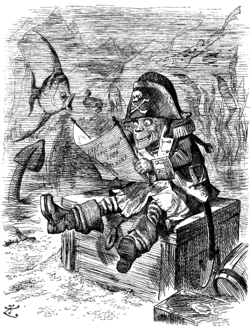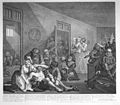Portal:Cartoon
The Cartoon Portal

A cartoon is a type of visual art that is typically drawn, frequently animated, in an unrealistic or semi-realistic style. The specific meaning has evolved, but the modern usage usually refers to either: an image or series of images intended for satire, caricature, or humor; or a motion picture that relies on a sequence of illustrations for its animation. Someone who creates cartoons in the first sense is called a cartoonist, and in the second sense they are usually called an animator.
The concept originated in the Middle Ages, and first described a preparatory drawing for a piece of art, such as a painting, fresco, tapestry, or stained glass window. In the 19th century, beginning in Punch magazine in 1843, cartoon came to refer – ironically at first – to humorous artworks in magazines and newspapers. Then it also was used for political cartoons and comic strips. When the medium developed, in the early 20th century, it began to refer to animated films that resembled print cartoons. (Full article...)

In print media, a cartoon is a drawing or series of drawings, usually humorous in intent. This usage dates from 1843, when Punch magazine applied the term to satirical drawings in its pages,[1] particularly sketches by John Leech.[2] The first of these parodied the preparatory cartoons for grand historical frescoes in the then-new Palace of Westminster in London.[3]

Sir John Tenniel—illustrator of Alice's Adventures in Wonderland—joined Punch in 1850, and over 50 years contributed over two thousand cartoons.[4]
Selected article -
Fritz the Cat is a 1972 American animated film written and directed by Ralph Bakshi (pictured) as his feature film debut. Based on the comic strip of the same name by Robert Crumb, the film was the first animated feature film to receive an X rating in the United States. It focuses on Fritz (voiced by Skip Hinnant), an anthropomorphic feline in mid-1960s New York City who explores the ideals of hedonism and sociopolitical consciousness. The film is a satire focusing on American college life of the era, race relations, the free love movement, and left- and right-wing politics. Fritz the Cat was the most successful independent animated feature of all time, grossing over $100 million worldwide. The film had a troubled production history and controversial release. Creator Robert Crumb is known to have had disagreements with the filmmakers, claiming in interviews that his first wife signed over the film rights to the characters, and that he did not approve the production. Crumb was also critical of the film's approach to his material. Fritz the Cat was controversial for its rating and content, which viewers at the time found to be offensive.
Selected character -
Superman is a fictional character and one of the most famous and popular comic book superheroes of all time. Created by American writer Jerry Siegel and Canadian artist Joe Shuster in 1932 while both were growing up in Cleveland, Ohio, and sold to Detective Comics Inc. the same year Superman debuted in Action Comics #1 (June 1938), the character has since appeared in radio serials, television programs, films, comic books, newspaper strips and video games, contributing to his long-standing ubiquity. Superman is born Kal-El on an alien planet — later named Krypton — and is rocketed to Earth as an infant by his scientist father moments before the planet's destruction. The rocket lands on Earth, where he is found by passing motorists who adopt him and give him the name Clark Kent. As Clark reaches maturity, he learns he has superhuman abilities which he resolves to use to help others, fighting anything from petty crime to universal threats. After adopting a Kryptonian fabric costume consisting of a blue shirt with a stylized "S" on the chest, a pair of red briefs over blue pants, a pair of red boots, and a red cape, he becomes Earth's champion, with the media giving him several nicknames including "The Man of Steel", "The Man of Tomorrow" and "The Last Son of Krypton". To keep his identity secret when not fighting evil as Superman, Clark lives among humanity as a "mild-mannered" reporter for the Metropolis newspaper The Daily Star (later changed to the Daily Planet). Clark works alongside reporter Lois Lane, with whom he is romantically involved (and married in the mainstream current comics' continuity).
Did you know... -
- ...that publication of comics in Hungary largely stopped during World War II due to Nazi pressure?
- ...that the Simpsons short Good Night aired April 19, 1987 on The Tracey Ullman Show and was the first ever appearance of the Simpson family on television?
- ...that Friz Freleng's 1937 cartoon Clean Pastures narrowly evaded Hollywood Production Code censors, before being removed from distribution by United Artists in 1968?
- ...that Ed, Edd n Eddy's TV movie series finale, Ed, Edd n Eddy's Big Picture Show, premiered on November 8, 2009, and achieved high ratings success for Cartoon Network?
Selected list -
There were 61 episodes of Avatar: The Last Airbender, an Emmy Award-winning American animated television series written and created by Michael Dante DiMartino (pictured) and Bryan Konietzko. It first aired on February 21, 2005 with a one-hour series premiere and concluded its run with a two-hour TV movie on July 19, 2008. The Avatar franchise refers to each season as a "Book", in which each episode is referred to as a "chapter". Each "Book" takes its name from one of the elements that the protagonist must master: Water, Earth, and Fire. The show's first two seasons each consisted of 20 episodes, while the third season had 21. In addition to the three seasons, there were two recap episodes and three "shorts". The first recap summarized the first eighteen episodes while the second summarized season two. The first self-parody was released via an online flash game. The second and third were released with the Complete Second Season Box Set DVD. The entire series has been released on DVD in both Region One and Region Two.
General images -
Selected biography -
Joseph Barbera (1911–2006) was an influential American animator, film director, film producer, storyboard artist, and cartoon artist. Born in New York City, after working odd jobs and as a banker, Barbera joined Van Beuren Studios in 1932 and subsequently Terrytoons in 1936. He met his lifelong collaborator William Hanna while working for Metro-Goldwyn-Mayer in 1937 and soon began producing animated shorts such as the Tom and Jerry series. In 1957, after MGM dissolved their animation department, they co-founded Hanna-Barbera, which became the most successful television animation studio in the business, producing programs such as The Flintstones, The Huckleberry Hound Show, Top Cat, The Jetsons, Scooby-Doo, The Quick Draw McGraw Show, The Smurfs, Wacky Races and Yogi Bear. Hanna and Barbera won seven Academy Awards and eight Emmy Awards. Their shows, which have translations in more than 20 languages, had a global audience in the 1960s of over 300 million people.
Subcategories
WikiProjects
- Main projects
- Arts • Animation • Comics • Entertainment • Visual arts
- Related Projects
- Anime and manga • Biography • Film • Fictional characters • Media franchises • Music • Television • Video games
Selected quote -
Topics
- Comic book
- Comic strip
- Digital comics
- Graphic novel
- Mobile comic
- Motion comics
- Trade paperback
- Webcomic
- Animator
- Animation director
- Animation studios
- Animation film festivals
- Feature-length films
- Short films
- Television series
- Computer-animated films
- Stop-motion films
- Traditional animation
- Limited animation
- Rotoscoping
- Stop Motion
- Clay
- Cutout
- Graphic
- Model
- Object
- Pixilation
- Puppetoon
- Computer animation
- Flash animation
- PowerPoint animation
- SVG animation
- Cel-shaded animation
- Crowd simulation
- Morph target animation
- Motion capture
- Non-photorealistic rendering
- Skeletal animation
Things you can do

- Requested articles: Fenwick (comics), Khimaera (comics), Mutant Underground Support Engine, Bruce J. Hawker, Marc Dacier, Hultrasson, Frankenstein Comics, Dave Johnson (comics), Paco Medina, Dappere Dodo, New Adventures of the Space Explorers, Habatales, Musical Box, Foo-Foo (TV series), Bonne nuit les petits, The Adventures of Lariat Sam, More...
- Images and photos needed: Request images that are needed from Wikipedia requested images of comics and animation to included in each articles.
- Stubs: Work on stubs in articles in Comics and Animation stubs.
- Infobox: Add infobox that are needed from Category:Comics articles without infoboxes and Category:Animation articles needing infoboxes in articles.
- Deletion sorting: Please see the collection of discussions on the deletion of articles related to comics and animation - compiled by WikiProject Deletion sorting
Related portals
Associated Wikimedia
The following Wikimedia Foundation sister projects provide more on this subject:
-
Commons
Free media repository -
Wikibooks
Free textbooks and manuals -
Wikidata
Free knowledge base -
Wikinews
Free-content news -
Wikiquote
Collection of quotations -
Wikisource
Free-content library -
Wikiversity
Free learning tools -
Wiktionary
Dictionary and thesaurus
More portals
Sources
- ^ Punch.co.uk. "History of the Cartoon". Archived from the original on 2007-11-11. Retrieved 2007-11-01.
- ^ Adler & Hill 2008, p. 30.
- ^ "Substance and Shadow: Original Editorial Accompanying "Cartoon, No. I"". Victorian web.org. Retrieved 29 October 2023.
- ^ "Sir John Tenniel". National Portrait Gallery. Retrieved 26 August 2022.






























